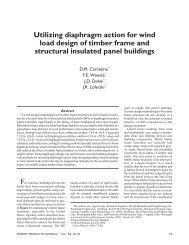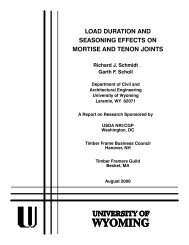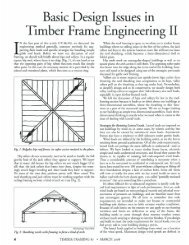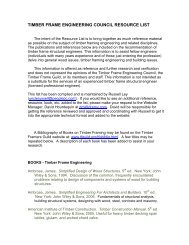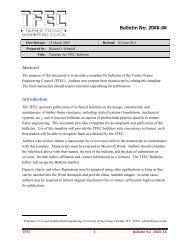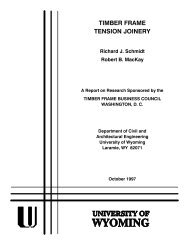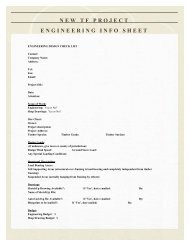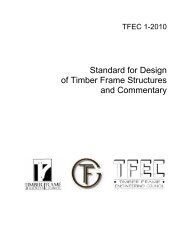Edge Spacing of Pegs in Mortise and Tenon Joints - Timber Frame ...
Edge Spacing of Pegs in Mortise and Tenon Joints - Timber Frame ...
Edge Spacing of Pegs in Mortise and Tenon Joints - Timber Frame ...
You also want an ePaper? Increase the reach of your titles
YUMPU automatically turns print PDFs into web optimized ePapers that Google loves.
<strong>Edge</strong> <strong>Spac<strong>in</strong>g</strong> <strong>of</strong> <strong>Pegs</strong> <strong>in</strong> <strong>Mortise</strong> <strong>and</strong> <strong>Tenon</strong> Jo<strong>in</strong>ts<br />
F<strong>in</strong>al Report<br />
By Daniel H<strong>in</strong>dman<br />
Prepared for<br />
<strong>Timber</strong> <strong>Frame</strong> Eng<strong>in</strong>eer<strong>in</strong>g Council
Introduction<br />
Perpendicular to gra<strong>in</strong> resistance is considered one <strong>of</strong> the weakest mechanical properties <strong>of</strong> wood<br />
due to the possibility <strong>of</strong> splitt<strong>in</strong>g. In most wood frame construction applications, perpendicular<br />
to gra<strong>in</strong> load<strong>in</strong>g is to be avoided. When these types <strong>of</strong> connections are created, the current wood<br />
design criteria <strong>in</strong> the United States imposes spac<strong>in</strong>g restrictions which are meant to limit splitt<strong>in</strong>g<br />
potential. However, most <strong>of</strong> the connections which are detailed <strong>in</strong> the National Design<br />
Specification for Wood Construction (NDS) use metal dowels <strong>in</strong> wood connections (AF&PA<br />
2005).<br />
The use <strong>of</strong> perpendicular to gra<strong>in</strong> connections is common <strong>in</strong> timber frame construction, where<br />
the st<strong>and</strong>ard fastener uses a wood dowel or peg rather than a metal dowel. Many timber frame<br />
jo<strong>in</strong>ts cannot conform to the NDS spac<strong>in</strong>g limitations, <strong>and</strong> previous practice, <strong>in</strong>clud<strong>in</strong>g research<br />
<strong>of</strong> mortise <strong>and</strong> tenon jo<strong>in</strong>ts, found that acceptable jo<strong>in</strong>t strength was achieved at lower spac<strong>in</strong>g<br />
<strong>in</strong>tervals. In fact, Goldste<strong>in</strong> (1999) states that many pegged mortise <strong>and</strong> tenon connections fall<br />
outside <strong>of</strong> the spac<strong>in</strong>g requirements <strong>of</strong> the NDS.<br />
Current NDS <strong>Spac<strong>in</strong>g</strong><br />
Splitt<strong>in</strong>g <strong>of</strong> the mortise member loaded by fasteners perpendicular to gra<strong>in</strong> was one <strong>of</strong> the<br />
identified failure modes from previous timber frame jo<strong>in</strong>t studies, such as Schmidt <strong>and</strong> Daniels<br />
(1999), <strong>and</strong> Miller (2004). The current approach <strong>of</strong> the NDS <strong>in</strong> the United States is to limit<br />
splitt<strong>in</strong>g behavior by restrict<strong>in</strong>g the edge distance <strong>of</strong> fasteners. The loaded edge distance for<br />
dowels loaded perpendicular to gra<strong>in</strong> is 4.0 times the diameter (4D). List<strong>in</strong>g distances as<br />
multiples <strong>of</strong> diameter <strong>of</strong> the bolt provides equivalent scal<strong>in</strong>g. Moss (1997) provides a review <strong>of</strong><br />
the research done to develop the current spac<strong>in</strong>g restriction. Reference to work by Mettem <strong>and</strong><br />
Page (1992) is made for perpendicular to gra<strong>in</strong> load<strong>in</strong>g, but little explanation <strong>of</strong> the choice <strong>of</strong><br />
loaded edge distances is provided.<br />
van der Put Model for Splitt<strong>in</strong>g Perpendicular to Gra<strong>in</strong><br />
The current perpendicular to gra<strong>in</strong> provisions for both the CSA 086 <strong>and</strong> Eurocode 5 are based<br />
upon a fracture mechanics model developed by van der Put (1990) to solve the case <strong>of</strong> notched<br />
beams, which is theoretically similar to the solution <strong>of</strong> a wooden member with a hole loaded<br />
perpendicular to gra<strong>in</strong>. Simplify<strong>in</strong>g assumptions <strong>in</strong>cluded the use <strong>of</strong> superposition, neglect<strong>in</strong>g<br />
normal forces <strong>in</strong> the member, <strong>and</strong> stable crack propagation. Crack propagation was <strong>in</strong>itiated<br />
when the loss <strong>of</strong> potential energy due to crack<strong>in</strong>g was equal to the required energy for crack<br />
formation. An additional requirement was that the fracture energy, G f , associated with crack<br />
propagation, must be <strong>of</strong> sufficient magnitude to propagate the crack <strong>in</strong> both the length <strong>and</strong> width<br />
directions <strong>of</strong> the beam (van der Put <strong>and</strong> Leijten 2000). The relationship for splitt<strong>in</strong>g failure,<br />
derived by van der Put <strong>and</strong> Leijten (2000) <strong>in</strong> Equation 1.<br />
2
V<br />
f<br />
b h<br />
=<br />
GG<br />
f<br />
α<br />
0.6 1<br />
( −α<br />
)<br />
(1)<br />
where,<br />
α = h e / h = location <strong>of</strong> the dowel with respect to the loaded edge <strong>and</strong> the beam height<br />
b = beam width, mm.<br />
h e = loaded edge distance, mm.<br />
h = beam height, mm.<br />
G = shear modulus <strong>of</strong> the material, N/mm 2<br />
G f = fracture energy, N/mm<br />
V f = the maximum shear force at fracture, N<br />
The fracture energy term, G f , as referred to by van der Put <strong>and</strong> Leijten (2000), assumes a<br />
comb<strong>in</strong>ed (mixed-mode) mode I <strong>and</strong> mode II <strong>in</strong>teraction. This <strong>in</strong>teraction was derived<br />
empirically by Petersson (1995), based on the relationship between tension perpendicular to<br />
gra<strong>in</strong> stress <strong>and</strong> shear stress. However, a simplify<strong>in</strong>g assumption <strong>of</strong> G f based only on mode I<br />
fracture, is a reasonably accurate approximation (Schoenmakers 2006). An alternate form <strong>of</strong><br />
Equation 1 is shown <strong>in</strong> Equation 2 (van der Put <strong>and</strong> Leijten 2000):<br />
b<br />
V f<br />
h<br />
=<br />
C 1<br />
α<br />
α<br />
( 1−<br />
)<br />
with<br />
GG f<br />
C<br />
1<br />
= (2)<br />
0.6<br />
Ehlbeck et al. (1989) <strong>and</strong> Baller<strong>in</strong>i (1999) conducted connection tests <strong>of</strong> nails <strong>and</strong> dowels loaded<br />
perpendicular-to-gra<strong>in</strong> <strong>in</strong> simply supported beams <strong>and</strong> determ<strong>in</strong>ed the apparent fracture<br />
parameter, C<br />
1, through calibration (van der Put <strong>and</strong> Leijten 2000). Successful calibration was<br />
also achieved by Reshke (1999) who tested simply supported <strong>and</strong> cantilevered spruce glulam<br />
beams with steel-timber-steel bolted connections loaded perpendicular-to-gra<strong>in</strong>, <strong>and</strong> Reffold et<br />
al. (1999) who tested punched metal plate connections loaded perpendicular-to-gra<strong>in</strong>. This<br />
calibration determ<strong>in</strong>ed the C 1 characteristic lower bound for loaded edge distance less than 70%<br />
<strong>of</strong> the depth <strong>of</strong> the member, def<strong>in</strong>ed as 2/3 <strong>of</strong> the lower bound, to be 10 N/mm 1.5 (van der Put <strong>and</strong><br />
Leijten 2000). Substitution <strong>of</strong> this value <strong>in</strong>to Equation 2, gives Equation 3.<br />
CSA 086<br />
V f α<br />
= 10<br />
(3)<br />
b h ( 1 − α )<br />
Section 10.4.4.7 provides the perpendicular to gra<strong>in</strong> splitt<strong>in</strong>g resistance, QS ri , for the CSA 086<br />
design code (Equation 4). The QS i term <strong>in</strong> Equation 5 has the same form as Equation 3 with the<br />
square root over depth term <strong>in</strong> the denom<strong>in</strong>ator removed, <strong>and</strong> the width (thickness) term brought<br />
to the right side <strong>of</strong> the equation (CSA 2009). The codes have an implicit assumption <strong>of</strong> 14.0<br />
3
N/mm 1.5 for C I . With the assumption <strong>of</strong> C I = 14.0 N/mm 1.5 , no material properties are <strong>in</strong>cluded<br />
<strong>in</strong> the splitt<strong>in</strong>g equations <strong>in</strong> the CSA 086, or the Eurocode 5 design. In CSA 086, the equation<br />
for QS i conta<strong>in</strong>s no terms related to the species <strong>of</strong> wood used <strong>in</strong> the connection (CSA 2009).<br />
Therefore, it is assumed that, accord<strong>in</strong>g to CSA 086, all wood materials – regardless <strong>of</strong> species,<br />
density, gra<strong>in</strong> orientation – have the same splitt<strong>in</strong>g resistance.<br />
QS<br />
ri<br />
w<br />
i<br />
( K K K )<br />
= φ QS<br />
(4)<br />
D<br />
SF<br />
T<br />
QS<br />
i<br />
d<br />
e<br />
= 14 t<br />
(5)<br />
d<br />
e<br />
1−<br />
d<br />
Where,<br />
t = member thickness, mm<br />
d e = effective member depth (loaded edge distance), mm<br />
d = member depth, mm<br />
f w = resistance factor for brittle failures (0.7)<br />
K D = load duration factor (1.15 for short term loads)<br />
K SF = service condition factor (1.0 for dry use)<br />
K T = adjustment for pressure preservative treatment (1.0 for untreated lumber)<br />
Eurocode 5 (EC5) Splitt<strong>in</strong>g Capacity<br />
A manifestation <strong>of</strong> Equation 3 appears <strong>in</strong> the European design code (Eurocode 5 or EC5) as a<br />
specific check <strong>of</strong> the splitt<strong>in</strong>g capacity for perpendicular-to-gra<strong>in</strong> connections <strong>in</strong> s<strong>of</strong>twoods<br />
(ENV 2005-1-1, 2004).<br />
he<br />
F90 , Rk<br />
= 14bw<br />
⎞<br />
⎜<br />
⎛ (6)<br />
h − e<br />
1 ⎟<br />
⎝ h ⎠<br />
Where:<br />
F 90,Rk = the characteristic splitt<strong>in</strong>g capacity, N<br />
w = modification factor for fastener type (1.0 for all but metal plate connectors)<br />
h e = loaded edge distance <strong>of</strong> the most distant fastener, mm<br />
h = member height, mm<br />
b = member width, mm<br />
Account<strong>in</strong>g for material type, load duration, <strong>and</strong> moisture content effects, the follow<strong>in</strong>g equation<br />
(Section 2.4.3 <strong>of</strong> Eurocode 5) relates the characteristic value (F 90.Rk ) to the design value (F 90,Rd )<br />
(ENV 2005-1-1, 2004):<br />
4
F90,<br />
Rk<br />
F90 , Rd<br />
= k<br />
mod<br />
(6)<br />
γ<br />
M<br />
Where,<br />
F 90,Rd = design splitt<strong>in</strong>g capacity, N<br />
k mod = partial factor for material properties = 1.3 for connections<br />
γ M = modification factor consider<strong>in</strong>g load duration <strong>and</strong> service moisture content ( = 0.9<br />
for solid wood/LVL under a short term load (less than one week) with moisture content<br />
not exceed<strong>in</strong>g 20%)<br />
Fracture Mechanics Models for Predict<strong>in</strong>g Splitt<strong>in</strong>g Perpendicular to Gra<strong>in</strong><br />
Several researchers have applied pr<strong>in</strong>ciples <strong>of</strong> fracture mechanics to predict the capacity<br />
resistance achieved before splitt<strong>in</strong>g occurs, as fracture mechanics perta<strong>in</strong> especially to brittle<br />
failure modes such as splitt<strong>in</strong>g. While a variety <strong>of</strong> different fracture models us<strong>in</strong>g various<br />
theories <strong>and</strong> assumptions exist, two <strong>of</strong> the most common fracture mechanics concepts applied to<br />
the splitt<strong>in</strong>g perpendicular to gra<strong>in</strong> are the previously mentioned van der Put model (van der Put<br />
<strong>and</strong> Leijten 2000) <strong>and</strong> the Jensen model (Jensen 2003). The Jensen model is described <strong>and</strong><br />
several research studies that have used these models for splitt<strong>in</strong>g perpendicular to gra<strong>in</strong> are<br />
presented.<br />
A quasi-non-l<strong>in</strong>ear fracture mechanics model (Jensen et al. 2003) was based upon beam-onelastic<br />
foundation (BEF) theory. A complete model derivation us<strong>in</strong>g the conventional stress<br />
method, f<strong>in</strong>ite element solution, <strong>and</strong> experimental validation was provided by Jensen et al.<br />
(2003). The model was based on an elastic Timoshenko beam with f<strong>in</strong>ite length, with support<br />
provided by l<strong>in</strong>ear elastic spr<strong>in</strong>gs connected to a stiff foundation. The foundation stiffness <strong>of</strong><br />
these spr<strong>in</strong>gs model the perpendicular to gra<strong>in</strong> strength <strong>and</strong> fracture performance <strong>of</strong> the wood.<br />
While this performance is non-l<strong>in</strong>ear, it is “represented by a l<strong>in</strong>ear response that is equivalent <strong>in</strong><br />
terms <strong>of</strong> peak tensile stress perpendicular to gra<strong>in</strong>, f t , <strong>and</strong> fracture energy dissipations, G f ”<br />
(Jensen et al. 2003). Failure criterion for the beam was def<strong>in</strong>ed as when the maximum stress is<br />
equal to f t <strong>of</strong> the wood (Jensen et al. 2003).<br />
The model equations for failure load <strong>of</strong> a s<strong>in</strong>gle dowel load<strong>in</strong>g a beam perpendicular to gra<strong>in</strong> are<br />
as follows (Jensen et al. 2003):<br />
P<br />
p<br />
20<br />
= µ PP<br />
, LEFM<br />
= µ b GG<br />
f<br />
he<br />
(4)<br />
3<br />
with<br />
2ς<br />
+ 1<br />
5 G 2EG<br />
f<br />
µ =<br />
<strong>and</strong> ς =<br />
2<br />
ς + 1<br />
3 E h f<br />
e<br />
t<br />
5
where,<br />
b = beam width, mm.<br />
h<br />
e<br />
= distance from the closest dowel to the loaded edge, mm.<br />
G = shear modulus <strong>of</strong> the material, N/mm 2<br />
G<br />
f<br />
= fracture energy perpendicular to gra<strong>in</strong> (mode I), N/mm<br />
E = modulus <strong>of</strong> elasticity <strong>of</strong> the material, N/mm 2<br />
f<br />
t<br />
= tensile strength perpependicular-to-gra<strong>in</strong>, N/mm 2<br />
P<br />
P , LEFM<br />
= the failure load as a LEFM solution, N<br />
P<br />
P<br />
= the failure load, N<br />
F<strong>in</strong>ite element model (FEM) analysis <strong>of</strong> a ‘symmetrical beam with one or more dowels’ was<br />
performed by Jensen et al. (2003) <strong>in</strong> order to determ<strong>in</strong>e the accuracy <strong>of</strong> the derivation based on<br />
BEF theory. Good correlation was shown between experimental failure loads <strong>of</strong> lam<strong>in</strong>ated<br />
veneer lumber (LVL) plate <strong>and</strong> beam specimens, <strong>and</strong> theoretical predictions. The theory was<br />
also applied to structural glued lam<strong>in</strong>ated timber (glulam) beams with relatively low span to<br />
beam depth ratios, <strong>and</strong> plate tests, performed by Yasumura (2001), Quenneville <strong>and</strong> Mohammad<br />
(2001), <strong>and</strong> Kasim <strong>and</strong> Quenneville (2002). The glulam plates showed good agreement between<br />
theoretical predictions <strong>and</strong> experimental results. The capacity <strong>of</strong> the glulam beams was shown to<br />
be over-predicted for larger loaded edge distances (Jensen et al. 2003).<br />
Snow et al. (2004a) analyzed the accuracy <strong>of</strong> the van der Put model for predict<strong>in</strong>g the splitt<strong>in</strong>g<br />
capacity <strong>of</strong> perpendicular to gra<strong>in</strong>, s<strong>in</strong>gle-dowel connections <strong>in</strong> lam<strong>in</strong>ated str<strong>and</strong> lumber (LSL).<br />
Comparisons between experimental results <strong>of</strong> connections loaded to ultimate strength, <strong>and</strong> model<br />
predictions, concluded that model predictions were relatively accurate. However, LSL<br />
connection members typically failed <strong>in</strong> bend<strong>in</strong>g, rather than by splitt<strong>in</strong>g propagat<strong>in</strong>g from the<br />
connection. Additional work from Snow et al. (2004b) extended experimental analysis <strong>of</strong><br />
perpendicular to gra<strong>in</strong> s<strong>in</strong>gle-dowel connections to <strong>in</strong>clude lam<strong>in</strong>ated veneer lumber (LVL) <strong>and</strong><br />
parallel str<strong>and</strong> lumber (PSL). Both materials exhibited splitt<strong>in</strong>g behavior at failure; analysis <strong>of</strong><br />
the van der Put model was not <strong>in</strong>cluded <strong>in</strong> the scope <strong>of</strong> the project. It should be noted that the<br />
experimental connection configurations <strong>of</strong> Snow et al. (2004a) <strong>and</strong> Snow et al. (2004b) both<br />
consisted <strong>of</strong> a 3/4 <strong>in</strong>. diameter dowel load<strong>in</strong>g the ma<strong>in</strong> member, <strong>of</strong> 3-1/2 <strong>in</strong>. depth, along the<br />
neutral axis. The loaded edge distance <strong>of</strong> this configuration, 2.33D, is considered unsatisfactory<br />
by current NDS requirements <strong>of</strong> a m<strong>in</strong>imum 4D loaded edge distance for perpendicular to gra<strong>in</strong><br />
connections.<br />
The models proposed by van der Put <strong>and</strong> Jensen represent current European work on connections<br />
caus<strong>in</strong>g splitt<strong>in</strong>g <strong>of</strong> wood perpendicular to gra<strong>in</strong>. The van der Put model relies upon the<br />
dimensions <strong>of</strong> the connection (height, loaded edge height), as well as the shear modulus <strong>and</strong><br />
fracture energy. The Jensen model uses the shear modulus, fracture energy, modulus <strong>of</strong><br />
elasticity <strong>and</strong> tension strength perpendicular to gra<strong>in</strong>. The simplification <strong>of</strong> the van der Put<br />
model that is currently used <strong>in</strong> the European design literature assumes a constant value <strong>of</strong> shear<br />
6
modulus <strong>and</strong> fracture energy for s<strong>of</strong>twoods <strong>and</strong> is only dependent upon the dimensions <strong>of</strong> the<br />
connection.<br />
The fracture energy <strong>and</strong> properties <strong>of</strong> hardwoods have been found by other authors, <strong>in</strong>clud<strong>in</strong>g the<br />
Wood H<strong>and</strong>book (USDA 2011) <strong>and</strong> are available for use <strong>in</strong> these models. Consider<strong>in</strong>g the use <strong>of</strong><br />
these equations for timber-frame jo<strong>in</strong>ts with peg connections, the precedent set by the TFEC<br />
st<strong>and</strong>ard (TFEC 2010) <strong>of</strong> us<strong>in</strong>g the Wood H<strong>and</strong>book properties seems most appropriate.<br />
Previous <strong>Timber</strong> <strong>Frame</strong> Jo<strong>in</strong>t Test<strong>in</strong>g<br />
Schmidt <strong>and</strong> Daniels (1999) measured a variety <strong>of</strong> pegged mortise <strong>and</strong> tenon connections us<strong>in</strong>g<br />
different species <strong>and</strong> dimensions. <strong>Mortise</strong> <strong>and</strong> tenon jo<strong>in</strong>t species <strong>in</strong>cluded southern yellow p<strong>in</strong>e<br />
(P<strong>in</strong>us spp.), recycled Douglas-fir (Psuedotsuga menziesii), <strong>and</strong> red oak (Quercus rubra). A<br />
range <strong>of</strong> peg diameters (0.75 <strong>in</strong>ch to 1.25 <strong>in</strong>ch), end distance (1.5D to 2D), <strong>and</strong> loaded edge<br />
distance (2D to 4D) were tested us<strong>in</strong>g a universal test<strong>in</strong>g mach<strong>in</strong>e with a displacement rate <strong>of</strong><br />
0.0005 <strong>in</strong>/sec. Miller (2004) used a mobile test frame with a h<strong>and</strong> pump to evaluate yellow<br />
poplar (Liriodendron tulipifera) jo<strong>in</strong>ts with various loaded edge distances from 1.5D to 3D.<br />
Jo<strong>in</strong>t failures <strong>in</strong>cluded peg failures, mortise splitt<strong>in</strong>g, <strong>and</strong> tenon splitt<strong>in</strong>g. Shear/bend<strong>in</strong>g was the<br />
dom<strong>in</strong>ant peg failure mode. Southern yellow p<strong>in</strong>e jo<strong>in</strong>ts with 1.25 <strong>in</strong>ch diameter octagonal oak<br />
pegs did not reach 5% <strong>of</strong>fset yield, but rather failed due to the development <strong>of</strong> a s<strong>in</strong>gle flexural<br />
peg h<strong>in</strong>ge with<strong>in</strong> the tenon. A peg bear<strong>in</strong>g failure identified as Mode I<br />
d was discovered from a<br />
review <strong>of</strong> previous research. Jo<strong>in</strong>t stiffness was not determ<strong>in</strong>ed. Specific gravity was the major<br />
factor affect<strong>in</strong>g peg bend<strong>in</strong>g yield strength with a positive correlation <strong>of</strong> 0.73. Peg shear yield<br />
strength <strong>in</strong>creased with specific gravity. (Schmidt <strong>and</strong> Daniels 1999)<br />
Purpose <strong>of</strong> Project<br />
The purpose <strong>of</strong> this project was to exam<strong>in</strong>e the perpendicular splitt<strong>in</strong>g behavior <strong>of</strong> pegged<br />
mortise <strong>and</strong> tenon connections. The focus <strong>of</strong> this work is the splitt<strong>in</strong>g <strong>of</strong> the mortise member<br />
only. To prevent failures related to the tenon or peg, these elements were replaced with steel<br />
components. Results <strong>of</strong> this work will be compared aga<strong>in</strong>st previous test<strong>in</strong>g <strong>of</strong> mortise <strong>and</strong> tenon<br />
pegged jo<strong>in</strong>ts to check if these modifications affects the connection. Another change to the<br />
experimental methods was the reuse <strong>of</strong> beams to allow test<strong>in</strong>g on both faces. If the splitt<strong>in</strong>g<br />
failure is only engag<strong>in</strong>g wood fibers between the peg <strong>and</strong> loaded edge, then the wood fibers on<br />
the other side <strong>of</strong> the beam should rema<strong>in</strong> unloaded. Experimental results will be compared with<br />
CSA 086 provisions for splitt<strong>in</strong>g perpendicular to gra<strong>in</strong>, previous test<strong>in</strong>g <strong>of</strong> jo<strong>in</strong>ts by Schmidt<br />
<strong>and</strong> Daniels (1999), <strong>and</strong> van der Put <strong>and</strong> Jensen fracture models.<br />
7
Methods <strong>and</strong> Materials<br />
The test protocol (Table 1) was developed to encompass the common range <strong>of</strong> species <strong>in</strong> timber<br />
fram<strong>in</strong>g as well as the range <strong>of</strong> edge spac<strong>in</strong>g previously tested by Schmidt <strong>and</strong> Daniels (1999)<br />
<strong>and</strong> Miller (2004). A total <strong>of</strong> 44 tests were conducted on 22 <strong>in</strong>dividual specimens. The doubl<strong>in</strong>g<br />
<strong>of</strong> the sample size was accomplished by turn<strong>in</strong>g each beam over <strong>and</strong> drill<strong>in</strong>g a second set <strong>of</strong><br />
holes for test<strong>in</strong>g. When possible, different hole sizes were used to make sure that the maximum<br />
distance between the holes was ma<strong>in</strong>ta<strong>in</strong>ed (i.e, a 3.0 <strong>in</strong>ch edge distance was used on one side,<br />
<strong>and</strong> a 1.0 <strong>in</strong>ch edge distance was used on the other).<br />
Table 1. Experimental Test<strong>in</strong>g <strong>of</strong> <strong>Timber</strong> <strong>Frame</strong> <strong>Mortise</strong>s<br />
<strong>Mortise</strong> Species <strong>Edge</strong> Distance, <strong>in</strong> Number <strong>of</strong> Samples<br />
1.0” 4<br />
1.5” 4<br />
Douglas fir<br />
2.0” 4<br />
(Pseudotsuga menziesii)<br />
2.5” 4<br />
3.0” 4<br />
Eastern White P<strong>in</strong>e<br />
(P<strong>in</strong>us strobus)<br />
White Oak<br />
(Quercus alba)<br />
1.5” 4<br />
2.0” 4<br />
2.5” 4<br />
3.0” 1<br />
1.5” 3*<br />
2.0” 3<br />
2.5” 2<br />
3.0” 3*<br />
* One sample <strong>of</strong> the White Oak 1.5” <strong>and</strong> two samples <strong>of</strong> the White Oak 3.0” used ¾”<br />
diameter bolts due to difficulties <strong>in</strong>stall<strong>in</strong>g 1” diameter bolts<br />
Test specimens were 6x8 nom<strong>in</strong>al timbers 6 feet long with a 6 <strong>in</strong>ch long by 2 <strong>in</strong>ch wide through<br />
mortise centered at the midspan <strong>of</strong> the beam. A steel tenon (Figure 1) was constructed <strong>of</strong> solid<br />
steel 6 <strong>in</strong>ches wide by 2 <strong>in</strong>ches long by 15 <strong>in</strong>ches long. The tenon had 2 – 1-1/16 <strong>in</strong>ch diameter<br />
holes spaced 3 <strong>in</strong>ches apart. Instead <strong>of</strong> st<strong>and</strong>ard wooden pegs, the connection used 1 <strong>in</strong>ch<br />
diameter Grade 8 bolts. In three <strong>in</strong>stances, difficulty <strong>in</strong> <strong>in</strong>stall<strong>in</strong>g the 1 <strong>in</strong>ch diameter bolts led to<br />
the <strong>in</strong>stallation <strong>of</strong> ¾ <strong>in</strong>ch diameter bolts for the White Oak Samples.<br />
8
Figure 1. Steel <strong>Tenon</strong> Used for <strong>Mortise</strong> Member Test<strong>in</strong>g<br />
Figure 2 is a photograph <strong>of</strong> the test<strong>in</strong>g setup with directional arrows show<strong>in</strong>g the transfer <strong>of</strong> load<br />
from the crosshead to the test frame. An MTS universal test<strong>in</strong>g mach<strong>in</strong>e with a 50,000 lb.<br />
capacity was used for all test<strong>in</strong>g. The crosshead <strong>and</strong> tenon member had an upward displacement<br />
rate <strong>of</strong> 0.01 <strong>in</strong>/m<strong>in</strong>. Holddowns were placed 4.5 feet apart <strong>and</strong> were attached to the support table<br />
by threaded rods to restra<strong>in</strong> the mortise member. Load <strong>and</strong> displacement <strong>of</strong> the tenon member<br />
were measured by the <strong>in</strong>tegrated load cell <strong>and</strong> LVDT with<strong>in</strong> the MTS universal test<strong>in</strong>g mach<strong>in</strong>e<br />
crosshead. A separate LVDT was placed at the edge <strong>of</strong> the mortise member to measure the<br />
movement <strong>of</strong> the mortise member. Load <strong>and</strong> displacement were cont<strong>in</strong>ually monitored<br />
throughout the test. Specimens were loaded until failure occurred <strong>and</strong> at least a 10% drop <strong>in</strong> load<br />
occurred. From the data collected, the yield load <strong>and</strong> maximum load were found. Initial l<strong>in</strong>ear<br />
stiffness <strong>of</strong> the jo<strong>in</strong>t was calculated as the load divided by the difference <strong>in</strong> displacement <strong>of</strong> the<br />
crosshead <strong>and</strong> displacement <strong>of</strong> the mortise member.<br />
Figure 2. Load<strong>in</strong>g <strong>of</strong> <strong>Mortise</strong> Specimens Show<strong>in</strong>g Steel <strong>Tenon</strong> <strong>and</strong> Holddowns<br />
9
Results<br />
The average <strong>and</strong> coefficient <strong>of</strong> variation (COV) values for the specific gravity, yield load,<br />
maximum load <strong>and</strong> stiffness are given <strong>in</strong> Table 2. Specific gravity values are listed for each<br />
species rather than <strong>in</strong>dividual edge distances to avoid repetition. In general, as the edge distance<br />
<strong>in</strong>creased, the yield load, maximum load <strong>and</strong> stiffness <strong>in</strong>creased. Interest<strong>in</strong>gly, many <strong>of</strong> the<br />
values decreased at the 3.0 <strong>in</strong>ch edge distance. Many <strong>of</strong> the yield load values were similar or<br />
only slightly less than the maximum load, demonstrat<strong>in</strong>g the brittle nature <strong>of</strong> these jo<strong>in</strong>ts. The ¾<br />
<strong>in</strong>ch diameter bolts used <strong>in</strong> some <strong>of</strong> the White Oak specimens did not affect the average results.<br />
Table 2. Experimental Test<strong>in</strong>g Results <strong>of</strong> <strong>Mortise</strong> Members<br />
Species<br />
Douglas fir, SG<br />
= 0.436 (6.6%<br />
COV)<br />
Eastern White<br />
P<strong>in</strong>e, SG= 0.331<br />
(7.7% COV)<br />
White Oak,<br />
SG=0.696<br />
(8.3% COV)<br />
<strong>Edge</strong><br />
Distance, <strong>in</strong><br />
Yield Load, lbs<br />
(COV)<br />
Maximum Load,<br />
lbs (COV)<br />
Stiffness, lb/<strong>in</strong><br />
(COV)<br />
1.0 2410 (29.9%) 2570 (28.5%) 41,500 (58.0%)<br />
1.5 3100 (15.1%) 3790 (22.5%) 53,500 (9.7%)<br />
2.0 4780 (19.4%) 5350 (10.6%) 102,000 (27.0%)<br />
2.5 4700 (35.0%) 5270 (37.3%) 89,600 (25.0%)<br />
3.0 7380 (27.0%) 7920 (28.8%) 72,200 (18.0%)<br />
1.5 2480 (27.5%) 2920 (38.7%) 39,300 (31.9%)<br />
2.0 2940 (45.0%) 3360 (35.8%) 63,700 (30.0%)<br />
2.5 4030 (48.3%) 4200 (43.0%) 62,300 (45.3%)<br />
3.0 4200 (59.2%) 4550 (58.7%) 60,700 (23.2%)<br />
1.0 8000 8000 102,000<br />
1.5 7900 (23.6%) 8700 (18.7%) 90,500 (4.4%)<br />
2.0 10,300 (25.8%) 11,700 (32.7%) 95,700 (21.0%)<br />
2.5 13,900 (0.1%) 16,000 (1.2%) 134,000 (2.8%)<br />
3.0 9900 (12.4%) 10,400 (16.3%) 70,000 (43.8%)<br />
Figure 3 is a graph <strong>of</strong> a typical load-displacement curve. After an <strong>in</strong>itial settlement load<strong>in</strong>g, the<br />
load <strong>and</strong> displacement <strong>in</strong>crease l<strong>in</strong>early until yield<strong>in</strong>g, which was accompanied by a small crack<br />
or splitt<strong>in</strong>g between the two holes. As the load cont<strong>in</strong>ues to <strong>in</strong>crease, the maximum load is<br />
achieved <strong>and</strong> is accompanied by a large crack.<br />
10
12000<br />
10000<br />
Load, lbs<br />
8000<br />
6000<br />
4000<br />
2000<br />
0<br />
-1.00 -0.90 -0.80 -0.70 -0.60 -0.50<br />
Displacement, <strong>in</strong><br />
Figure 3. Load-Displacement Curve <strong>of</strong> a <strong>Mortise</strong> Specimen Show<strong>in</strong>g Brittle Behavior<br />
Four different failures <strong>of</strong> the specimens were identified. All failures were brittle. The most<br />
common failure was a splitt<strong>in</strong>g <strong>of</strong> the beam at or near the centerl<strong>in</strong>e <strong>of</strong> the bolts (Figure 4).<br />
Some <strong>of</strong> the specimens with larger loaded edge distances (2.5D to 3D) experienced splitt<strong>in</strong>g <strong>in</strong><br />
conjunction with a bend<strong>in</strong>g failure (Figure 5) on one side <strong>of</strong> the split. Another failure observed<br />
<strong>in</strong> only a few beams was a shear crack (Figure 6), which extended from one bolt to the loaded<br />
edge at a 45 degree angle. The shear crack occurred near a large knot on the top surface <strong>of</strong> the<br />
mortise member. This crack was <strong>of</strong>ten associated with a knot near the mortise. F<strong>in</strong>ally, one<br />
specimen, the third white oak beam with a 2D loaded edge distance, experienced a split <strong>in</strong> l<strong>in</strong>e<br />
with the previously tested holes on the specimen. The split (Figure 7) traveled along the entire<br />
length <strong>of</strong> the specimen <strong>and</strong> acted to reduce the section, thereby lower<strong>in</strong>g the stiffness value <strong>of</strong><br />
this sample.<br />
11
Figure 4. Splitt<strong>in</strong>g Failure Observed for Majority <strong>of</strong> Samples<br />
Figure 5. Splitt<strong>in</strong>g <strong>and</strong> Bend<strong>in</strong>g Failure Observed for Larger Loaded <strong>Edge</strong> Distances<br />
Figure 6. Shear Crack Failure At Bolt Hole<br />
12
Figure 7. Split Failure Extend<strong>in</strong>g Through Previously Tested Bolt Holes<br />
The experimental values were statistically compared to exam<strong>in</strong>e differences <strong>in</strong> the species, edge<br />
distance, <strong>and</strong> specific gravity <strong>of</strong> the mortise. The factors <strong>of</strong> species <strong>and</strong> specific gravity were<br />
used to determ<strong>in</strong>e if the difference <strong>in</strong> experimental values was due to characteristics <strong>of</strong> a species<br />
(i.e., wood anatomy) versus a change <strong>in</strong> specific gravity. The p-values from an analysis <strong>of</strong><br />
variance (ANOVA) test are shown <strong>in</strong> Table 3. For the yield load <strong>and</strong> maximum load, both the<br />
specific gravity <strong>and</strong> edge spac<strong>in</strong>g were significantly different (p < 0.05). For the stiffness, only<br />
the edge distance was significantly different (p < 0.05), while the specific gravity was not<br />
significantly different (p = 0.4645). The species factor was not significant for any <strong>of</strong> the<br />
experimental measures, <strong>in</strong>dicat<strong>in</strong>g wood anatomy was not found to result <strong>in</strong> the different<br />
mechanical properties.<br />
Table 3. Statistical Results <strong>of</strong> <strong>Edge</strong> <strong>Spac<strong>in</strong>g</strong> <strong>and</strong> Specific Gravity Factors (α=0.05)<br />
Factor Yield Load Maximum Load Stiffness<br />
Species 0.3981 0.3259 0.0635<br />
<strong>Edge</strong> <strong>Spac<strong>in</strong>g</strong> 0.0001 0.0003 0.0004<br />
Specific Gravity 0.0056 0.0063 0.4645<br />
Interaction 0.1889 0.0318 0.0238<br />
13
Interaction <strong>of</strong> the edge distance <strong>and</strong> specific gravity terms, however, were significant for the<br />
maximum load <strong>and</strong> the stiffness. Investigation <strong>of</strong> the <strong>in</strong>teraction plots shows a consistent trend<br />
for the maximum load; however, for the stiffness, the 2.0 <strong>and</strong> 3.0 edge distances decreased as<br />
specific gravity <strong>in</strong>creased, while the other edge distances did not. For the yield load <strong>and</strong><br />
maximum load, the specific gravity showed a positive trend (greater specific gravity, greater<br />
load).<br />
For the edge distance values, a Tukey’s Honestly Significant Difference (HSD) test was<br />
conducted. The Tukey’s HSD is able to identify sub-groups, denoted by letters, <strong>of</strong> significant or<br />
not significant factor levels with<strong>in</strong> the edge distance term (Table 4). For the yield load,<br />
maximum load, <strong>and</strong> stiffness, values for the three largest edge distances (3.0, 2.5, 2.0) were NOT<br />
significantly different. For the yield load <strong>and</strong> maximum load, the values at 2.0 <strong>and</strong> 1.5 were not<br />
significantly different, <strong>and</strong> the values at 1.5 <strong>and</strong> 1.0 were not significantly different. The<br />
stiffness values at 3.0, 1.5 <strong>and</strong> 1.0 were not significantly different, which is the basis for the<br />
previous comments about some <strong>of</strong> the stiffness terms at the 3.0 loaded edge distance be<strong>in</strong>g less<br />
than the proceed<strong>in</strong>g loaded edge distance. The edge distance terms that were considered not<br />
significantly different may only require future test<strong>in</strong>g <strong>of</strong> fewer levels – say 1.0, 2.0, 3.0 edge<br />
distances – to adequately assess the change <strong>in</strong> load due to edge distance. This f<strong>in</strong>d<strong>in</strong>g may help<br />
to optimize future mortise <strong>and</strong> tenon test<strong>in</strong>g.<br />
Table 4. Tukey’s HSD Results for the <strong>Edge</strong> Distance Factor<br />
<strong>Edge</strong> Distance Yield Load Maximum Load Stiffness<br />
3.0 A A A B<br />
2.5 A A A<br />
2.0 A B A B A<br />
1.5 B C B C B<br />
1.0 C C B<br />
Experimental Results Compared to CSA 086 / EC-5<br />
The calculated values <strong>of</strong> QS ri from Equation 4 are shown <strong>in</strong> Table 5 for different edge distance<br />
<strong>and</strong> diameter <strong>of</strong> peg. The width value, t, <strong>in</strong> Equation 4 is equal to the mortise width m<strong>in</strong>us the<br />
section removed for the tenon. These values are <strong>in</strong>sensitive to mechanical properties <strong>of</strong> the<br />
wood, or changes <strong>in</strong> species or specific gravity. The appendix section shows the values used <strong>and</strong><br />
the calculation <strong>of</strong> the QS ri values.<br />
14
Table 5. QS ri Results From CSA 086 For Comparison to Experimental Values<br />
<strong>Edge</strong> Distance, D Diameter <strong>of</strong> Peg (D), <strong>in</strong> QS ri , lbs<br />
1.5 0.75 1310<br />
3 0.75 2040<br />
1 1 1220<br />
1.5 1 1550<br />
2 1 1880<br />
2.5 1 2200<br />
3 1 2540<br />
Figure 8 is a graph <strong>of</strong> the maximum load for each wood species <strong>and</strong> the CSA 086 values from<br />
Table 5. Each species is highlighted <strong>in</strong> a different color <strong>and</strong> shape. Note the white oak values<br />
that reflect the previous discussion on specific gravity, while the Douglas fir <strong>and</strong> eastern white<br />
p<strong>in</strong>e values are similar. The l<strong>in</strong>e represents the CSA 086 values, which do <strong>in</strong>crease with an<br />
<strong>in</strong>crease <strong>in</strong> loaded edge distance. The CSA 086 values appear lower on the chart, mak<strong>in</strong>g them<br />
conservative compared to the average values for the white oak, Douglas fir <strong>and</strong> eastern white<br />
p<strong>in</strong>e tested.<br />
Maximum Load, lbs<br />
18000<br />
16000<br />
14000<br />
12000<br />
10000<br />
8000<br />
6000<br />
CSA 086 QS(ri)<br />
Douglas fir<br />
Eastern White<br />
P<strong>in</strong>e<br />
White oak<br />
4000<br />
2000<br />
0<br />
0.5 1 1.5 2 2.5 3 3.5<br />
<strong>Edge</strong> Distance, D<br />
Figure 8. Comparison <strong>of</strong> the Experimental Maximum Load <strong>and</strong> CSA 086 Values<br />
15
As the specific gravity <strong>in</strong>creases, the CSA 086 values become even more conservative. For<br />
<strong>in</strong>stance, the CSA 086 curve <strong>in</strong> Figure 8 has two <strong>of</strong> the eastern white p<strong>in</strong>e load values above <strong>and</strong><br />
below the curve, while the curve has all Douglas fir values above the curve. All white oak<br />
values are approximately three times the CSA 086 curve. The van der Put model, which the<br />
CSA 086 was derived from, was focused on s<strong>of</strong>twood materials, particularly spruce, with<br />
specific gravity values similar <strong>in</strong> the range <strong>of</strong> 0.4 to 0.5, which is similar the Douglas fir values.<br />
Incorporat<strong>in</strong>g a specific gravity term <strong>in</strong> the QS ri equation for timber frame mortise members may<br />
improve the prediction. However, the current CSA 086 values can serve as a lower bound for<br />
Douglas fir, eastern white p<strong>in</strong>e, <strong>and</strong> white oak mortise members.<br />
Experimental Results Compared to Schmidt <strong>and</strong> Daniels<br />
Figures 9, 10, 11 are graphs <strong>of</strong> the maximum load <strong>and</strong> edge distance for the experimental results,<br />
<strong>and</strong> data from Schmidt <strong>and</strong> Daniels (1999) for each species. Work by Schmidt <strong>and</strong> Daniels<br />
(1999) was used for comparison due to the similarities <strong>in</strong> specific gravity with the experimental<br />
results. Figure 9 is a comparison <strong>of</strong> Douglas fir values (average SG = 0.436) with Recycled<br />
Douglas fir (average SG = 0.505). Figure 10 is a comparison <strong>of</strong> eastern white p<strong>in</strong>e values<br />
(average SG = 0.331) with southern yellow p<strong>in</strong>e (average SG = 0.55). Figure 11 is a comparison<br />
<strong>of</strong> red oak values (average SG = 0.696) with red oak values (average SG = 0.65).<br />
The values from Schmidt <strong>and</strong> Daniels (1999) are all with<strong>in</strong> the range <strong>of</strong> the experimental values<br />
tested. Statistical tests could not compare the experimental data values to Schmidt <strong>and</strong> Daniels<br />
(1999) because <strong>of</strong> the small number <strong>of</strong> samples. It should be noted that some <strong>of</strong> the Schmidt <strong>and</strong><br />
Daniels (1999) data used other variables not considered <strong>in</strong> this work, such as changes <strong>in</strong> peg<br />
diameter <strong>and</strong> peg species. A full list<strong>in</strong>g <strong>of</strong> the Schmidt <strong>and</strong> Daniels (1999) data used is shown <strong>in</strong><br />
the Appendix. The test<strong>in</strong>g <strong>of</strong> both sides <strong>of</strong> the mortise members did not seem to affect the<br />
maximum load values.<br />
16
12000<br />
10000<br />
Experimental<br />
Schmidt <strong>and</strong> Daniels<br />
Maximum Load, lbs<br />
8000<br />
6000<br />
4000<br />
2000<br />
0<br />
0.5 1 1.5 2 2.5 3 3.5<br />
<strong>Edge</strong> Distance, D<br />
Figure 9. Comparison <strong>of</strong> Douglas fir Experimental Values with Recycled Douglas fir<br />
Values from Schmidt <strong>and</strong> Daniels (1999)<br />
8000<br />
7000<br />
Experimental<br />
Schmidt <strong>and</strong> Daniels<br />
Maximum Load, lbs<br />
6000<br />
5000<br />
4000<br />
3000<br />
2000<br />
1000<br />
1 1.5 2 2.5 3 3.5<br />
<strong>Edge</strong> Distance, D<br />
Figure 10. Comparison <strong>of</strong> Eastern White P<strong>in</strong>e Experimental Values with Southern Yellow<br />
P<strong>in</strong>e Values from Schmidt <strong>and</strong> Daniels (1999)<br />
17
18000<br />
16000<br />
Experimental<br />
Schmidt <strong>and</strong> Daniels<br />
Maximum Load, lbs<br />
14000<br />
12000<br />
10000<br />
8000<br />
6000<br />
0.5 1 1.5 2 2.5 3 3.5<br />
<strong>Edge</strong> Distance, D<br />
Figure 11. Comparison <strong>of</strong> White Oak Maximum Load with Red Oak Values from Schmidt<br />
<strong>and</strong> Daniels (1999)<br />
Figures 12, 13 <strong>and</strong> 14 are graphs <strong>of</strong> the stiffness <strong>and</strong> loaded edge distance for the experimental<br />
results <strong>and</strong> data from Schmidt <strong>and</strong> Daniels (1999) for each species. Similar to the maximum<br />
load values, the stiffness terms from Schmidt <strong>and</strong> Daniels (1999) overlapped the experimental<br />
results, <strong>in</strong>dicat<strong>in</strong>g similar values from the two test methods.<br />
18
200000<br />
180000<br />
160000<br />
Experimental<br />
Schmidt <strong>and</strong> Daniels<br />
Stiffness, lb/<strong>in</strong><br />
140000<br />
120000<br />
100000<br />
80000<br />
60000<br />
40000<br />
20000<br />
0.5 1 1.5 2 2.5 3 3.5<br />
<strong>Edge</strong> Distance, D<br />
Figure 12. Comparison <strong>of</strong> Douglas fir Stiffness Values with Recycled Douglas fir from<br />
Schmidt <strong>and</strong> Daniels<br />
120000<br />
Stiffness, lb/<strong>in</strong><br />
110000<br />
100000<br />
90000<br />
80000<br />
70000<br />
60000<br />
Experimental<br />
Schmidt <strong>and</strong> Daniels<br />
50000<br />
40000<br />
30000<br />
20000<br />
1 1.5 2 2.5 3 3.5 4 4.5<br />
<strong>Edge</strong> Distance, D<br />
Figure 13. Comparison <strong>of</strong> Eastern White P<strong>in</strong>e Stiffness Values with Southern Yellow P<strong>in</strong>e<br />
Values from Schmidt <strong>and</strong> Daniels (1999)<br />
19
145000<br />
125000<br />
Experimental<br />
Schmidt <strong>and</strong> Daniels<br />
105000<br />
Stiffness, lb/<strong>in</strong><br />
85000<br />
65000<br />
45000<br />
25000<br />
0.5 1 1.5 2 2.5 3 3.5<br />
<strong>Edge</strong> Distance, D<br />
Figure 14. Comparison <strong>of</strong> White Oak Stiffness Values with Red Oak Values from Schmidt<br />
<strong>and</strong> Daniels (1999)<br />
Experimental Results Compared to Other Fracture Models<br />
In addition to comparisons <strong>of</strong> the CSA 086 design values <strong>and</strong> previous research by Schmidt <strong>and</strong><br />
Daniels (1999), comparisons <strong>of</strong> the experimental results were made with fracture mechanics<br />
predictions from the van der Put model <strong>and</strong> the Jensen model. To create the fracture mechanics<br />
model predictions, the mechanical properties <strong>of</strong> the mortise members were needed. Samples <strong>of</strong><br />
the mortise members were taken after test<strong>in</strong>g, <strong>and</strong> there are future plans to measure the modulus<br />
<strong>of</strong> elasticity, tension perpendicular to gra<strong>in</strong>, <strong>and</strong> the fracture energy. Unfortunately, it does not<br />
appear that shear modulus can be exam<strong>in</strong>ed for these specimens. Shear modulus test<strong>in</strong>g requires<br />
either a long beam for torsion or repeated bend<strong>in</strong>g tests, or a large, th<strong>in</strong> square plate for anticlastic<br />
load<strong>in</strong>g.<br />
Us<strong>in</strong>g properties <strong>in</strong> the Wood H<strong>and</strong>book, sets <strong>of</strong> mechanical properties for the Douglas fir,<br />
eastern white p<strong>in</strong>e <strong>and</strong> white oak are shown <strong>in</strong> Table 6. Values for modulus <strong>of</strong> elasticity <strong>and</strong><br />
tension strength perpendicular to gra<strong>in</strong> were given at green <strong>and</strong> 12% moisture content values.<br />
Us<strong>in</strong>g the formulas <strong>in</strong> the Wood H<strong>and</strong>book <strong>and</strong> the moisture content <strong>of</strong> the <strong>in</strong>dividual beams<br />
measured after test<strong>in</strong>g, the modulus <strong>of</strong> elasticity <strong>and</strong> tension strength perpendicular to gra<strong>in</strong> were<br />
estimated for each <strong>in</strong>dividual beam (See Appendix). Shear modulus is presented as a ratio <strong>of</strong> the<br />
modulus <strong>of</strong> elasticity after moisture content was adjusted. The fracture energy values were not<br />
20
found <strong>in</strong> the Wood H<strong>and</strong>book. A value <strong>of</strong> 4.37 lb/<strong>in</strong> was measured by F<strong>in</strong>kenb<strong>in</strong>der (2007) for<br />
southern p<strong>in</strong>e material. This value was used for all three species to ga<strong>in</strong> an estimate <strong>of</strong> the<br />
fracture capacity.<br />
Table 6. Mechanical Properties <strong>of</strong> <strong>Mortise</strong> Members for van der Put <strong>and</strong> Jensen Fracture<br />
Models<br />
Mechanical<br />
Property<br />
Douglas fir (Coastal) Eastern White P<strong>in</strong>e White Oak<br />
Modulus <strong>of</strong><br />
Elasticity (E)<br />
1.56x10 6 psi [Green]<br />
1.95x10 6 psi [12% MC]<br />
0.99x10 6 psi [Green]<br />
1.24x10 6 psi [12% MC]<br />
1.25x10 6 psi [Green]<br />
1.78x10 6 psi [12% MC]<br />
Ratio <strong>of</strong> Elastic<br />
Modulus to<br />
Shear Modulus<br />
1.0 : 0.064 1.0 : 0.052 1 1.0 : 0.086<br />
(G), G LR :E L<br />
Tension<br />
Perpendicular to<br />
Gra<strong>in</strong> Strength<br />
300 psi [Green]<br />
340 psi [12% MC]<br />
250 psi [Green]<br />
310 psi [12% MC]<br />
770 psi [Green]<br />
800 psi [12% MC]<br />
(f tperp )<br />
Fracture Energy Used Eastern White<br />
Used Eastern White<br />
4.37 lb/<strong>in</strong><br />
(G f )<br />
P<strong>in</strong>e Value<br />
P<strong>in</strong>e Value<br />
1 S<strong>in</strong>ce no Eastern White P<strong>in</strong>e value was available, Western White P<strong>in</strong>e was used.<br />
Figures 15, 16, <strong>and</strong> 17 are graphs compar<strong>in</strong>g the maximum load experimental results with values<br />
from the van der Put <strong>and</strong> Jensen models. For all three wood species, the van der Put values were<br />
less than the Jensen values. Both the van der Put <strong>and</strong> Jensen models produced similar slopes<br />
(van der Put slope = 1907.5 lbs/<strong>in</strong>ch, Jensen slope = 2324.5 lbs/<strong>in</strong>). As seen <strong>in</strong> the CSA 086<br />
values, the van der Put <strong>and</strong> Jensen models do not account for specific gravity. These models<br />
were calibrated for s<strong>of</strong>twood timbers <strong>and</strong> did not <strong>in</strong>clude an adjustment for specific gravity. For<br />
the Douglas fir <strong>and</strong> eastern white p<strong>in</strong>e, the values for the van der Put <strong>and</strong> Jensen models were<br />
greater than all experimental data. For the white oak, the values <strong>of</strong> the van der Put <strong>and</strong> Jensen<br />
models were close to the average experimental values. F<strong>in</strong>kenb<strong>in</strong>der (2007) also found that the<br />
van der Put model overestimated LVL bolted connections. Improvements to the mechanical<br />
property estimates may lower the value <strong>of</strong> the models. However, these models are not seen as a<br />
great improvement over the CSA 086 model used.<br />
21
12000<br />
10000<br />
Experimental<br />
van der Put<br />
Jensen<br />
Maximum Load, lbs.<br />
8000<br />
6000<br />
4000<br />
2000<br />
0<br />
0.5 1 1.5 2 2.5 3 3.5<br />
<strong>Edge</strong> <strong>Spac<strong>in</strong>g</strong>, D<br />
Figure 15. Comparison <strong>of</strong> Douglas fir Maximum Load Values with Fracture Mechanics<br />
Models<br />
9000<br />
8000<br />
7000<br />
Experimental<br />
van der Put<br />
Jensen<br />
Maximum Load, lbs<br />
6000<br />
5000<br />
4000<br />
3000<br />
2000<br />
1000<br />
0<br />
1 1.5 2 2.5 3 3.5 4 4.5<br />
<strong>Edge</strong> Distance, D<br />
Figure 16. Comparison <strong>of</strong> Eastern White P<strong>in</strong>e Maximum Load Values with Fracture<br />
Mechanics Models<br />
22
18000<br />
Maximum Load, lbs<br />
16000<br />
14000<br />
12000<br />
10000<br />
8000<br />
6000<br />
Experimental<br />
van der Put<br />
Jensen<br />
4000<br />
2000<br />
0<br />
0.5 1 1.5 2 2.5 3 3.5<br />
<strong>Edge</strong> Distance, D<br />
Figure 17. Comparison <strong>of</strong> Douglas fir Maximum Load Values with Fracture Mechanics<br />
Models<br />
Conclusions<br />
This project measured the splitt<strong>in</strong>g resistance <strong>of</strong> mortise members <strong>in</strong> perpendicular to gra<strong>in</strong><br />
pegged mortise <strong>and</strong> tenon jo<strong>in</strong>ts. A novel test apparatus has a steel tenon <strong>and</strong> Grade 8 bolts to<br />
restrict failures to the mortise member. Also, the timbers were tested on both sides <strong>of</strong> the<br />
mortise to <strong>in</strong>crease the possible test repetitions. Yield load, maximum load, <strong>and</strong> stiffness values<br />
<strong>in</strong>creased as edge distance <strong>in</strong>creased. As specific gravity <strong>in</strong>creased, the yield load <strong>and</strong> maximum<br />
load <strong>in</strong>creased. No damage was noted from test<strong>in</strong>g the jo<strong>in</strong>ts on both sides. CSA 086 values,<br />
us<strong>in</strong>g the width as the rema<strong>in</strong><strong>in</strong>g cross-sectional width <strong>of</strong> the mortise, represented a lower bound<br />
for all maximum load values. The CSA 086 values <strong>in</strong>creased with edge distance, but not with<br />
specific gravity. The CSA 086 estimation could be used as a basel<strong>in</strong>e estimate <strong>of</strong> splitt<strong>in</strong>g<br />
resistance for the wood species <strong>of</strong> connections tested. Compar<strong>in</strong>g the experimental data to<br />
Schmidt <strong>and</strong> Daniels (1999), the maximum load <strong>and</strong> stiffness values were <strong>in</strong> the same range,<br />
<strong>in</strong>dicat<strong>in</strong>g that no difference between the metal/wood test <strong>and</strong> test<strong>in</strong>g the jo<strong>in</strong>ts on both sides was<br />
detected. The van der Put <strong>and</strong> Jensen models were greater than the Douglas fir <strong>and</strong> eastern white<br />
p<strong>in</strong>e values, <strong>and</strong> were similar to the white oak values. Ref<strong>in</strong>ement <strong>of</strong> the models by mechanical<br />
properties may be helpful, but the CSA 086 model <strong>in</strong> current form seemed to be a better<br />
prediction <strong>of</strong> splitt<strong>in</strong>g resistance.<br />
23
References<br />
American Forest <strong>and</strong> Paper Association (AF&PA). 2005. National Design Specification for<br />
Wood Construction. American Forest <strong>and</strong> Paper Association, Wash<strong>in</strong>gton, D.C.<br />
Baller<strong>in</strong>i, M. 1999. A New Set <strong>of</strong> Experimental Tests on Beams Loaded Perpendicular to Gra<strong>in</strong><br />
by Dowel Type Jo<strong>in</strong>ts. CIB-W18 meet<strong>in</strong>g thirty-two, paper 32-7-2, Graz, Austria.<br />
Canadian St<strong>and</strong>ards Association (CSA). 2009. 086-09 Eng<strong>in</strong>eer<strong>in</strong>g Design <strong>in</strong> Wood. Canadian<br />
St<strong>and</strong>ards Association. Mississauga, Ontario, CA.<br />
Ehlbeck, J, R. Gorlacher, <strong>and</strong> H. Werner. 1989. Determ<strong>in</strong>ation <strong>of</strong> Perpendicular to Gra<strong>in</strong> Tensile<br />
Stresses <strong>in</strong> Jo<strong>in</strong>ts with Dowel-Type Fasteners – a Draft Proposal for Design Rules. CIB-<br />
W18 meet<strong>in</strong>g twenty-two, paper 22-7-2, Berl<strong>in</strong>, Germany.<br />
ENV 2005-1-1 Eurocode 5. 2004. Design <strong>of</strong> <strong>Timber</strong> Structures, Part 1. Comite Europeen de<br />
Normalisation, Brussels, Belgium.<br />
F<strong>in</strong>kenb<strong>in</strong>der, D. E. 2007. An Experimental Investigation <strong>of</strong> Structural Composite Lumber<br />
Loaded by a Dowel <strong>in</strong> Perpendicular to Gra<strong>in</strong> Orientation at Yield <strong>and</strong> Capacity. M.S.<br />
Thesis. Virg<strong>in</strong>ia Tech. 180 p.<br />
Goldste<strong>in</strong>, E. W. 1999. <strong>Timber</strong> Construction for Architects <strong>and</strong> Builders. McGraw Hill. New<br />
York, NY. 436 p.<br />
Jensen, J.L, P.J. Gustafsson, <strong>and</strong> H.J. Larsen. 2003. A Tensile Fracture Model for Jo<strong>in</strong>ts with<br />
Rods or Dowels Loaded Perpendicular to Gra<strong>in</strong>. CIB-W18 meet<strong>in</strong>g thirty-six, paper 36-<br />
7-9, Colorado, USA.<br />
Jensen, J.L. 2003. Splitt<strong>in</strong>g Strength <strong>of</strong> Beams Loaded by Connections. CIB-W18 meet<strong>in</strong>g<br />
thirty-six, paper 36-7-8, Colorado, USA.<br />
Kasim, M. <strong>and</strong> J.H.P. Quenneville. 2002. Effect <strong>of</strong> Row <strong>Spac<strong>in</strong>g</strong> on the Capacity <strong>of</strong><br />
Perpendicular to Gra<strong>in</strong> Loaded <strong>Timber</strong> Jo<strong>in</strong>ts with Multiple <strong>Timber</strong> Connections Loaded<br />
Perpendicular to Gra<strong>in</strong>. CIB-W18 meet<strong>in</strong>g thirty-five, paper 35-7-6, Kyoto, Japan.<br />
Mettem, C. J., <strong>and</strong> A. V. Page. 1992. Load distributions <strong>in</strong> multi-fastener bolted jo<strong>in</strong>ts <strong>in</strong><br />
European whitewood glulam with steel sideplates. CIB W18 meet<strong>in</strong>g twenty-five, paper<br />
25-7-12, Ahus, Sweden.<br />
Miller, J. F. 2004. "Capacity <strong>of</strong> Pegged <strong>Mortise</strong> <strong>and</strong> <strong>Tenon</strong> Jo<strong>in</strong>ts." Master's Thesis., University<br />
<strong>of</strong> Wyom<strong>in</strong>g, Laramie, Wyom<strong>in</strong>g.<br />
Moss, P. J. 1997. Multiple-Bolted Jo<strong>in</strong>ts <strong>in</strong> Wood Members: A Literature Review. USDA<br />
Forest Products Laboratory. FPL-GTR-97. Madison, WI.<br />
Petterson, H. 1995. Fracture Mechanics <strong>of</strong> <strong>Timber</strong> Beams <strong>and</strong> End Notches. CIB-W18 meet<strong>in</strong>g<br />
twenty-eight, paper 28-19-3, København, Danmark<br />
24
Quenneville, J.H.P, <strong>and</strong> M. Mohammad. 2001. A Proposed Canadian Design Approach for<br />
Bolted Connections Loaded Perpendicular to Gra<strong>in</strong>. Jo<strong>in</strong>ts <strong>in</strong> <strong>Timber</strong> Structures,<br />
Proceed<strong>in</strong>gs <strong>of</strong> the International RILEM Symposium, Stuttgart, Germany.<br />
Reffold, A., T.N. Reynolds, <strong>and</strong> B.S. Choo. 1999. An Investigation <strong>in</strong>to the Tensile Strength <strong>of</strong><br />
Nail Plate <strong>Timber</strong> Jo<strong>in</strong>ts Loaded Perpendicular to the Gra<strong>in</strong>. Journal <strong>of</strong> the Institute <strong>of</strong><br />
Wood Science. 15(1).<br />
Reshke, R.G. 1999. Bolted <strong>Timber</strong> Connections Loaded Perpendicular-to-Gra<strong>in</strong>. Ph.D.<br />
dissertation. Royal Military College <strong>of</strong> Canada. K<strong>in</strong>gston, Ontario. 294 p.<br />
Schmidt, R. J., <strong>and</strong> C. E. Daniels. 1999. "Design Considerations for <strong>Mortise</strong> <strong>and</strong> <strong>Tenon</strong><br />
Connections," Master's Thesis., University <strong>of</strong> Wyom<strong>in</strong>g, Laramie, Wyom<strong>in</strong>g.<br />
Schoenmakers, J.C.M. 2006. PhD C<strong>and</strong>idate, Delft University <strong>of</strong> Technology, Delft, The<br />
Netherl<strong>and</strong>s. Electronic mail correspondence. August, 2006.<br />
Snow, M., I. Smith, <strong>and</strong> A. Asiz. 2004a. Dowel Jo<strong>in</strong>ts <strong>in</strong> Eng<strong>in</strong>eered Wood Products:<br />
Assessment <strong>of</strong> Simple Fracture Mechanics Models. CIB-W18 meet<strong>in</strong>g thirty-seven,<br />
paper 37-7-15, Ed<strong>in</strong>burgh, Scotl<strong>and</strong>. 12 p.<br />
Snow, M., A. Asiz, <strong>and</strong> I. Smith. 2004b. Failure Behaviour <strong>of</strong> S<strong>in</strong>gle Dowel Connections <strong>in</strong><br />
Eng<strong>in</strong>eered Wood Products. 5 th Structural Specialty Conference <strong>of</strong> the Canadian Society<br />
for Civil Eng<strong>in</strong>eer<strong>in</strong>g. Saskatoon, Saskatchewan, Canada. 9 p.<br />
<strong>Timber</strong> <strong>Frame</strong> Eng<strong>in</strong>eer<strong>in</strong>g Council (TFEC). 2010. St<strong>and</strong>ard for Design <strong>of</strong> <strong>Timber</strong> <strong>Frame</strong><br />
Structures <strong>and</strong> Commentary, TFEC 1-2010. <strong>Timber</strong> <strong>Frame</strong> Eng<strong>in</strong>eer<strong>in</strong>g Council, Becket,<br />
MA.<br />
United States Department <strong>of</strong> Agriculture (USDA). 2011. Wood H<strong>and</strong>book: Wood As An<br />
Eng<strong>in</strong>eer<strong>in</strong>g Material. USDA. Wash<strong>in</strong>gton, DC.<br />
Van der Put, T.A.C.M. 1990. Tension Perpendicular to Gra<strong>in</strong> at Notches <strong>and</strong> Jo<strong>in</strong>ts. CIB-W18<br />
meet<strong>in</strong>g twenty-three, paper 23-10-1, Lisbon, Portugal.<br />
Van der Put, T.A.C.M. <strong>and</strong> A.J.M. Leijten. 2000. Evaluation <strong>of</strong> Perpendicular to Gra<strong>in</strong> Failure<br />
<strong>of</strong> Beams Caused by Concentrated Loads at Jo<strong>in</strong>ts. CIB-W18 meet<strong>in</strong>g thirty-three, paper<br />
33-7-7, Delft, The Netherl<strong>and</strong>s.<br />
Yasumura, M. 2001. Criteria for Damage <strong>and</strong> Failure <strong>of</strong> Dowel-Type Jo<strong>in</strong>ts Subjected to Force<br />
Perpendicular to Gra<strong>in</strong>. CIB-W18 meet<strong>in</strong>g thirty-four, paper 34-7-9, Venice, Italy.<br />
25




